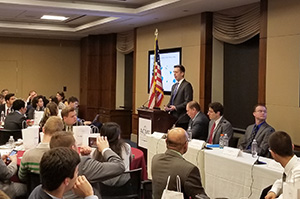ASME Congressional Briefing Roadmaps Large Scale Energy Storage
ASME Congressional Briefing Roadmaps Large Scale Energy Storage
In mid-June, ASME hosted a congressional briefing on the state of large scale energy storage technologies. The event, “Large Scale Energy Storage: Road to Realization,” was organized in partnership with Representative Jerry McNerney (CA-9th), co-chair of the Grid Innovation Congressional Caucus, and the ASME Energy Conversion and Storage (ECS) segment. The briefing featured expert speakers on the state of large scale energy storage technologies, as well as an overview of the regulatory environment for deployment and utilization of energy storage in the United States.
There are several technologies available for storing electricity for power grid applications, and in recent years, considerable interest in new battery storage options for power grid applications. Renewable and clean energy sources in particular can benefit from increased grid storage deployment, as they are often reliant on fluctuating natural conditions that create challenges for grid operators who must ensure reliable, low-cost electricity. Large scale energy storage systems can help integrate renewable energy resources and improve the efficiency of the power grid. At the same time, they can maintain or improve grid reliability and resilience by providing grid operators with additional flexibility.
Bob Stakenborghs, P.E. and ASME ECS representative, moderated the briefing and provided an introduction to the topic for an audience of about 100 congressional staff members and others from the science and technology policy community. Panelists included Paul Denholm, principal energy analyst at the National Renewable Energy Laboratory (NREL); Brian Miller, strategic team lead for microgrids at NREL; Ray Hohenstein, market applications director at Fluence, a Siemens and AES company; and Jason Burwen, vice president of policy for the Energy Storage Association.
In addition to providing a detailed overview of major energy storage technologies, the briefing also detailed how energy storage can solve some major economic inefficiencies in traditional electricity markets, where peak demand targets and uncertain demand forecasting can drive expensive and inefficient infrastructure investments. In recent years, battery storage costs have declined significantly, prompting new investments in grid-scale battery storage from companies like Fluence.
The Federal Energy Regulatory Commission and several states have taken some initial steps to support this emerging market segment, but many in Congress are calling for additional reforms to allow faster uptake and deployment of large scale energy storage systems, with more than 10 bipartisan bills currently under consideration in the House and Senate. Proposed legislative reforms include expanding investment tax credits treatment to include energy storage, electricity market reforms, and infrastructure investments in grid-scale demonstration projects.




